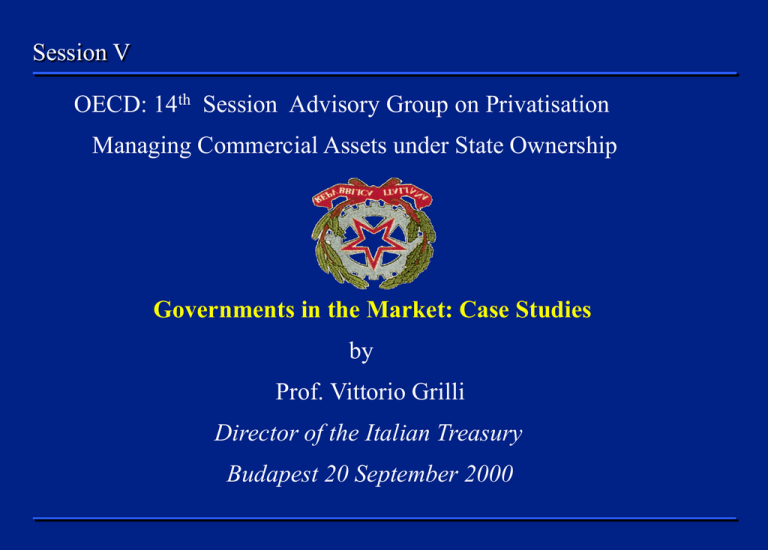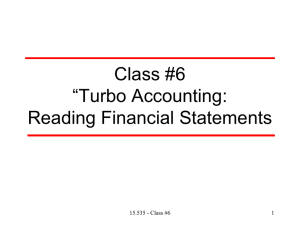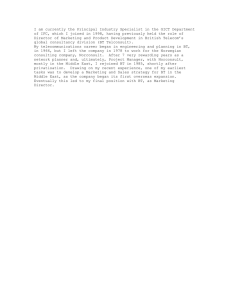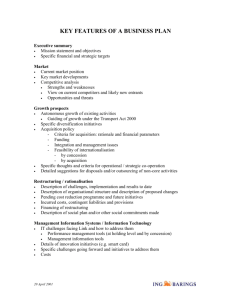Session V OECD: 14 Session Advisory Group on Privatisation
advertisement

Session V OECD: 14th Session Advisory Group on Privatisation Managing Commercial Assets under State Ownership Governments in the Market: Case Studies by Prof. Vittorio Grilli Director of the Italian Treasury Budapest 20 September 2000 Summary Government’s new role in the market has made the underlying tensions among possibly conflicting roles and objectives more acute Multiple roles: Multiple objectives: Reducing public debt ,deficit and Pusuing “national interest”(public) Set economic policy (public) Share holder (private) Liberalisation & fostering competition (public) Reduce State’s role in economy (public) Granting licences (public) Max value of assets (private) Client Publ. Procurement Sell at best conditions (priv) Improve efficency and transparency of financial mkts (priv) Facilitate change in control and protect minority share holders (public) Regulator (public) (public/private) Actions Possible solutions to conflicting roles:separate as early as possible, roles and agencies responsible for them: 1 Regulator Independent Authority 2 Set economic policy Line Ministry 3 Shareholder Treasury 4 Granting licences Prime Ministerial committee 5 Client Transparent public procurement 6 Improve financial mkts efficency Privatise banking and Stock Exch 7 Transparency change in control, protecting minority shareholders New corporate governance Despite clear roles, conflicts are probably inevitable. (ie 6 and 7 are not due to conflicting objectives , but from vested interest groups) Usual clash refers to: 4 and 5 vs 2 and 1 1 vs 3 Corporate Governance and Transparency Insider trading Takeover rules Retail investment Minorities’ rights Change of corporate control Privatisation rules and procedures Listing requirements Corporate Governance Mechanisms Special Shareholding Voting List Proxy Powers Limits System Voting CREDIT BCI IMI INA ENI TELECOM IT . AUTOSTRADE ENEL FINMECC. Development of Competition for Corporate Control TENDER OFFER RULES Notice by bidder/target Offer document Passivity rule Mandatory offers Competing offers Shareholders Agreements Evolving Ownership Structure for Privatised Companies FOLLOWING PRIVATISATION (*) UNICREDITO IMI 14.5% Core Shareholders 85.5% Free Float 37% Banking foundations 3% Allianz 60% Free float 41% Compagnia di San Paolo and other core shareholders 59% Free float 18% Core Shareholders 82% Free Float 85% Generali 9% San Paolo 6% Free float BANCA COMMERCIALE ITALIANA 100% Free Float 70% Intesa 30% Free float SEAT PAGINE GIALLE 61% Controlling Shareholders 39% Free Float TELECOM ITALIA 10.6% Core Shareholders 89.4% Free Float INA (*) 100% Free Float TO DATE (*) % ownership refers to ordinary share capital; (**) Pro-forma merger with tin.it 64% Telecom Italia (**) 36% Free float (**) 55% Tecnost - 3.9% Treasury 41.1% Free float Selected Case Studies Privatised in November 1997 through: Public offering Private placement with core shareholders Tender offer on TI shares launched by Olivetti in Feb 1999 Privatised in June 2000 Recapitalisation in April 1998 Merger with MEI (23% of STMicroelectronics) in Dec 1999 30% held by Treasury following privatisation Privatised in July 2000 IPO in July 1997 Sold majority to trade buyer Tender offer on ADR market float to be launched in Oct 2000 Privatisation Process and Following Events 1996 Spin off of mobile business 1998 - 2000 1997 Merger STET/TI (TIM) Management change STET transferred from Removal of holding IRI to Italian Treasury shares company discount SEAT demerger Sale of SEAT through a TI privatisation Management change following completion of tender offer competitive auction Olivetti’s tender offer on TI Spin off of Internet division (tin.it) Merger SEAT/tin.it TI’s Privatisation: Facts and Figures PRIVATISATION METHODOLOGY Public offering + private placement with core shareholders 84% sold to Italian retail investors (10% to TI employees) 16% sold to institutional investors PUBLIC OFFERING (EURO 9.6 BN) PRIVATE PLACEMENT (EURO 2.2 BN) CORPORATE GOVERNANCE 10% TI’s ordinary share capital sold to core shareholders No formal concert among core shareholders Lock-up provisions Special powers granted to Italian Treasury 3% shareholding limit for 3 years Voting list system Olivetti’s Tender Offer on TI FEBRUARY Olivetti announces its intent to launch a tender offer for 100% of TI’s ordinary share capital at e10 per share, valuing TI at e52.6 bn TI responds with its defence plan (financing package + cash tender on TIM minorities shares) Olivetti raises its bid to e 11.5 per ordinary share MARCH APRIL MAY TI’s Extraordinary Shareholders Meeting summoned to approve the defence plan fails to reach the required 30% quorum TI and Deutsche Telekom announce that they have agreed to a e 76 bn “merger of equals” Olivetti’s tender offer is officially launched with the offer period to last 17 working days TI announces that, in case Olivetti’s tender offer is unsuccessful, it would implement the buy-back program on ordinary shares at e9.5 per share Olivetti’s tender offer closes with Olivetti reaching a 52.1% acceptance level Olivetti’s Tender Offer on TI – Issues Faced by Treasury Special Powers Veto right on mergers and purchases of TI’s shares over 3% Olivetti’s tender offer on TI Proposed merger with Deutsche Telekom (controlled by German State) Share Ownership (3.0%) Attendance to shareholders meeting “30% rule” for bid defences Preserve Treasury’s economic interest Decide on acceptance to tender offer Applicability in case of acceptance level Shareholding Limit 3% limit lapses if tender offer is launched on 100% of ordinary share capital below 50% Treasury adopted a neutral stance toward the tender offer, leaving to market forces the success or failure of the bid Privatisation Process 1997 Consolidated losses Euro 1.2 bn Turnaround plan 23% stake in STM 1.0 bn Euro 1.1 bn cash Very diversified business Strategic alliances portfolio Corporate streamlining/ sector peers cost rationalisation Divestiture of non core assets (EBPA, ASI) Merger with MEI Net debt Euro 5.1 bn Low market share vis-à-vis Recapitalisation Euro 2000 1998 - 1999 Restructuring of Energy and Transportation Privatisation Finmeccanica’s Strategic Alliances Prior to privatisation Finmeccanica formed several strategic alliances in each of its core businesses: Joint Venture partner has been selected for its specific skills in the sector Strategic equity interest supported by shareholders agreement and management deployment Key objectives of the joint ventures were: Transform Finmeccanica from a conglomerate into an industrial holding company Create new companies able to play a major role in a consolidating sector Enhance shareholders value Finmeccanica’s International Joint Ventures BUSINESS SECTOR COMPANY PARTNER EQUITY INTEREST DEFENCE AMS BAE Systems 50% HELICOPTERS Agusta-Westland GKN 50% MISSILES MBD BAE Systems/EADS 25% AERONAUTICS EMAC EADS 50% SPACE Astrium EADS Pending Finmeccanica’s Privatisation: Facts and Figures PRIVATISATION METHODOLOGY RETAIL OFFERING INSTITUTIONAL OFFERING Public offering on Italian and international markets (Euro 5.7 bn) Concurrent convertible offering (Euro 0.8 bn) launched by Finmeccanica 1.9x oversubscribed 1.2 million requests 76% of total offer allocated to retail 2.0x oversubscribed 26.3% to US investors 29.3% to Italian investors 44.4% to RoW investors Corporate Governance post Privatisation Considering Finmeccanica’s presence in the defence sector, the Italian Government decided to keep a significant equity stake in Finmeccanica (30%) and retain a “Golden Share” Voting list system for retail and institutional investors have been introduced in the Company’s by-laws SPECIAL POWERS SHAREHOLDING LIMIT Approval of material acquisitions of shares (3%) Approval of material shareholders’ agreement (relating to 3% or more of Finmeccanica’ share capital) Appointment of members of the Board of Directors and Statutory Auditors Veto powers (dissolution, transfer of business, mergers) No more than 3% of the company held by any natural and legal person for a period of 3 years Limit can be exceeded if a tender offer is launched on 100% of the company’ share capital (Law 474) Privatisation Process 1997 1995 COFIRI and a group of financial investors acquired ADR from Alitalia Successful IPO of ADR shares, priced at the top of the announced range (Euro 5.68 per share). Total consideration equalled approximately Euro 307 mn for 45% of ADR’s capital 1999 - 2000 DPCM establishing the regulatory framework for the privatisation procedure Local Authorities exercised their option to acquire a 3% stake IRI and Consorzio Leonardo signed the contract for the sale of IRI’s 51.2% interest in ADR IRI transferred its ADR shares to Consorzio Leonardo Privatisation Objectives and Options The objective of the privatisation was to maximise the proceeds from the sale as well as to preserve public interests relating to the Rome airport system The alternatives considered included: Public offering Public offering with core shareholders Trade sale A trade sale procedure was identified as the best option to maximise value and allow for a stable shareholder base for ADR Privatisation Issues ISSUE ACTION Put in place a “real” privatisation No more than 2% of ADR to be held by State-owned companies Conflicts of interest Airlines excluded from sale procedure Maximise proceeds Two-stage competitive auction Support from Local Authorities Option to 4 Local Authorities to acquire a 3% stake in the company Stakeholders’ interests Detailed business plan to be presented by final bidders Minority shareholders Mandatory public tender on market float Privatisation Results The divestiture method selected for the privatisation of ADR proved to be successful The auction process proved to be very competitive, for the benefit of IRI and the minority shareholders The price paid to IRI by the winning bidder (10.8 Euro per share) implied a significant premium to ADR’s pre-bid market price In compliance with the tender offer rules the price that will be paid to the minority shareholders (9.13 Euro per share) is equal to the average between the weighted average price of ADR shares over the last 12 months and the price per share paid to IRI Several contractual obligations have been undertaken by the acquiror: Launch of a tender offer on the remaining ADR share capital 5 years lock-up period for the shares acquired from IRI Maintenance of employment levels for 3 years Implementation of business plan and financial viability





